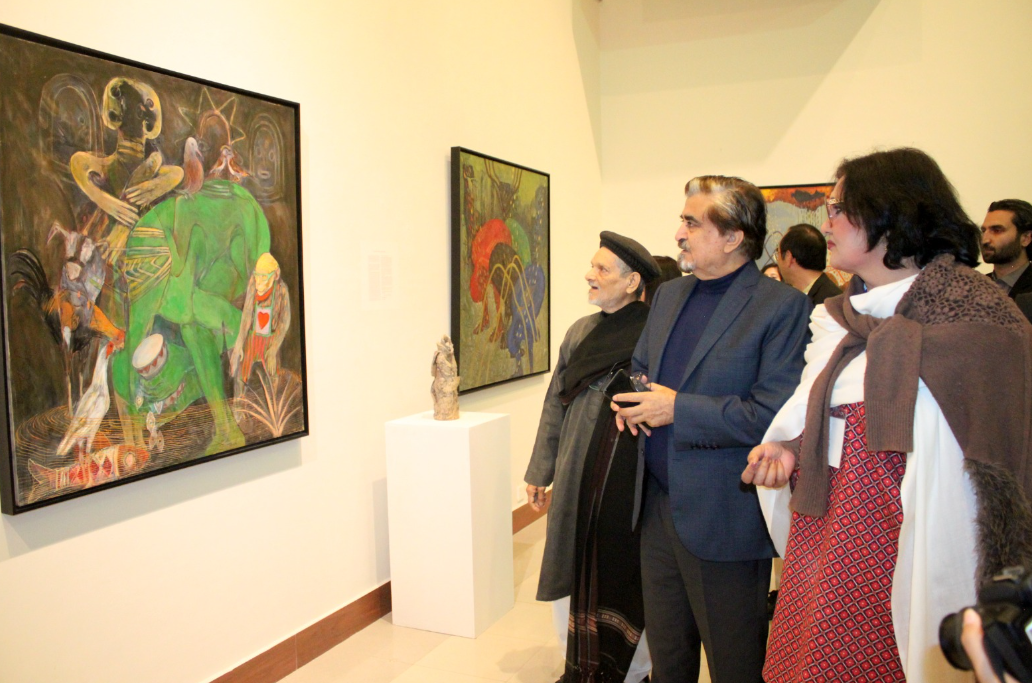
ISLAMABAD: Acclaimed miniature painter Ustad Bashir Ahmed on Sunday inaugurated an exhibition of Jamal Shah’s paintings titled ‘Celebration of Dehumanized Existence’ at Pakistan National Council of Arts.
Carrying a universal interpretation beyond peace, positivity and harmony, the collection has been praised for its deep symbolism and message.
Federal Minister for National Heritage and Culture Jamal Shah is an acclaimed visual artist. In most paintings, he used Murgha symbolically to create an atmosphere of parody, remorse and growing struggle. The minister believed that the salvation of humanity lies in making a positive contribution to the well-being of the less fortunate who lack daily bread and health care.
Jamal Shah’s paintings and sculptures are about subjects so inquisitive, searching and heartbreaking that it seems almost trite to describe his subject matter. His work embedded itself in the viewer’s consciousness by seeming to grope toward an understanding of how he should respond to the world in which he lived. The return to painting reaffirmed Shah’s belief in the permanence and intellectual nature of the medium, the sense that the painted image requires a unique, uncompromising confrontation between viewer and object.
He was almost unique in reinventing the paradigm of socialist painting. Consequently, his description of the images focuses attention on the notion that the combined images represent the history of the working class – dispossessed and disenfranchised. The new set of images thus offers memories of the victory of British colonialism and reflects the decline of working-class identity in the confrontation with right-wing agendas.
It is clear that these paintings, entitled “Celebration of Dehumanized Existence”, exhibited at the PNCA National Art Gallery in Islamabad, are a response to a specific set of historical circumstances. This helps explain both the controversy and the urgency of the display.
In the first place, Shah imbued the images with symbols, allusions and questions. There are recurring emblems of working class struggle: spade and axe, monkey and work thrown as murgha – a stress position used as corporal punishment.
The figures are based on an earlier installation called Situations 101, created for the 2017 Karachi Biennale and later re-installed at PNCA, Islamabad, which combined the human figure with social realism as public art. The language of culture and art, he reckoned, is an effective and just platform that gives people voice and intellectual emancipation.
In his welcome remarks, M. Ayoub Jamali, Director General of PNCA, expressed his deep honor to host Jamal Shah’s first solo exhibition at the National Gallery of Art.
He described the show as amazing and emphasized the importance of showcasing Shah’s work in a national space.
In his speech, Jamal Shah said, “As an artist, my work is a reflection of the society in which I live. It is an attempt to engage in dialogue with my fellow man, to explore and face the contradictions and struggles that exist within. our company.
He said that through my paintings, sculptures and ceramic works, I hope to start a dialogue that can engage people towards the best possible path for our society. I believe that art has a responsibility to serve humanity, to contribute to the betterment of society.
Ultimately, the goal of every creative individual is to reach a level of existence that can be called aesthetic, where truth triumphs over deception and where there is complete transparency. My work is a reflection of this struggle and I hope it can serve as a catalyst for positive change in our world.
Ustad Bashir Ahmed, a renowned Pakistani miniature artist and also a teacher of Jamal Shah, was the chief guest while speaking on the occasion, he said that the expression Jamal Shah does not contain any riddles or secrets and is spiritually decipherable by almost any section of the society. The works depict the natural urge of human beings to interact, despite differences and fears, creating intersections between cultures, he added.
With an innate sense of patriotism, he always tried to inculcate a sense of civic and moral responsibility among the masses through his work. His deeply insightful images promote pragmatic development through unification and sharing.
The exhibition will last until March 3, 2024, daily from 10 a.m. to 4 p.m. The gallery will be closed on Saturday.






